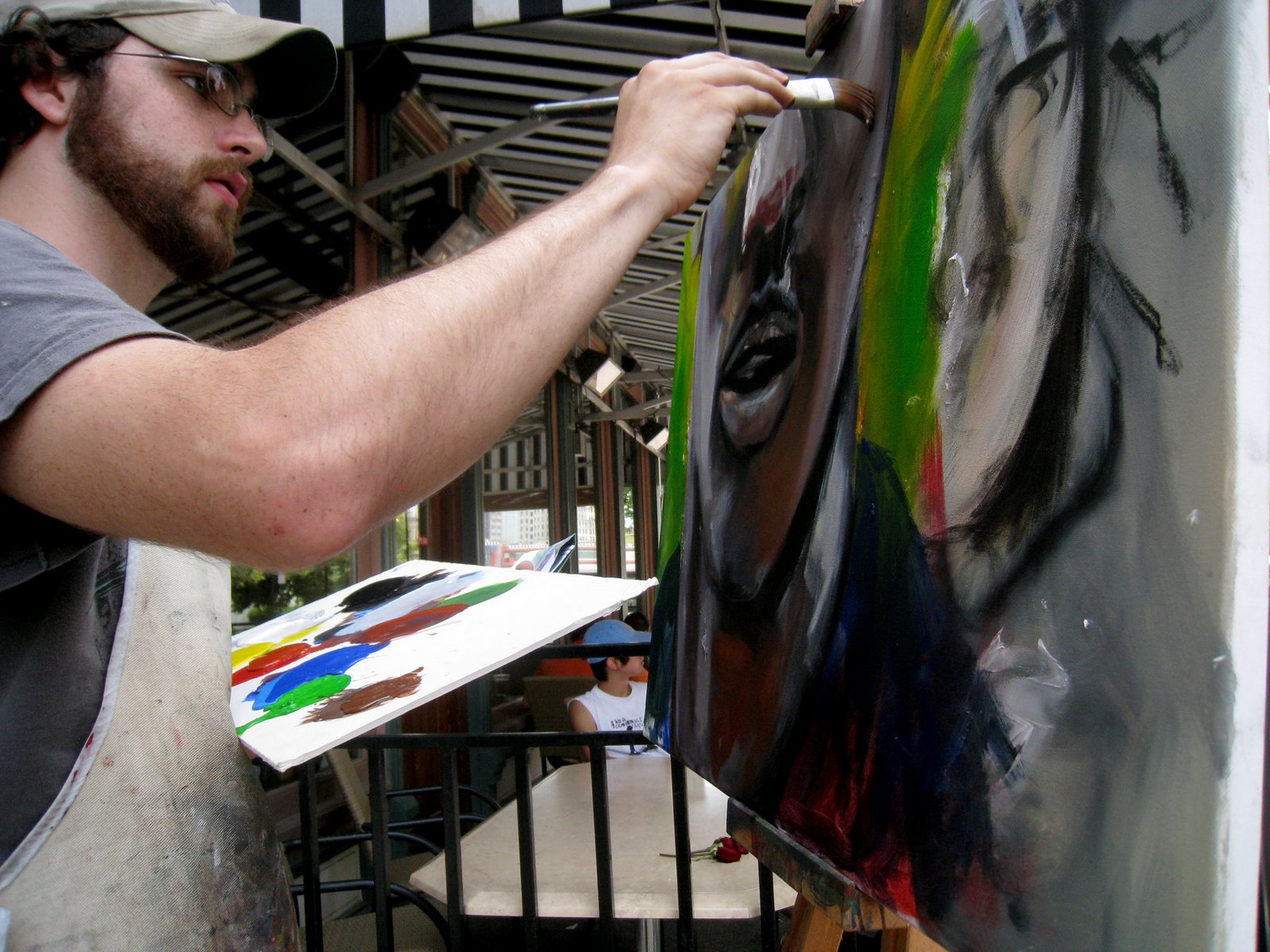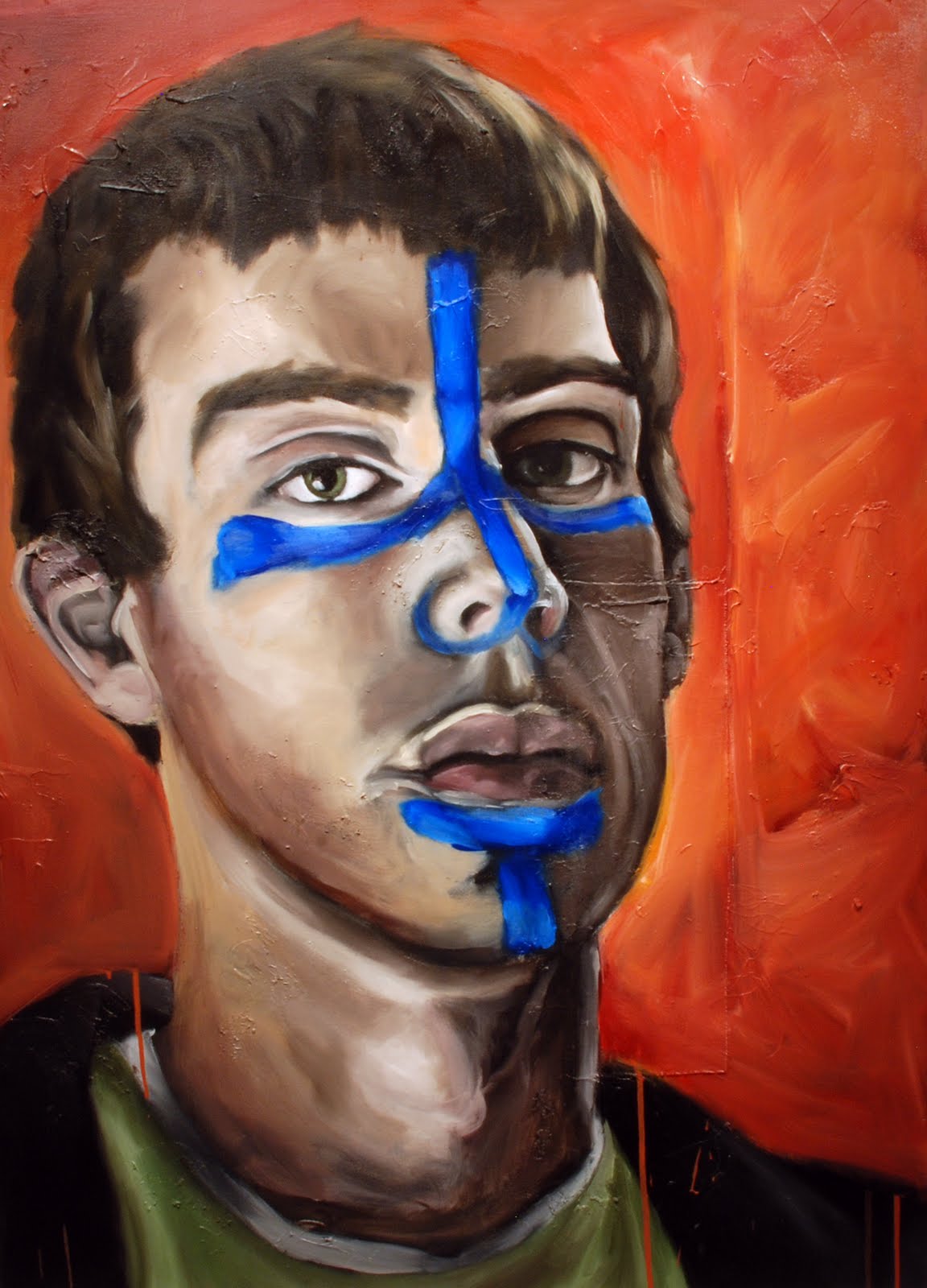Interview: Ben Norton, Painter
Ben Norton is a figurative painter currently residing in Dayton, Ohio. Originally from Nashville, Tennessee, Ben came to Ohio to study at the University of Dayton. In May of 2009, he graduated with a Bachelor's degree in Fine Arts, concentrating in painting and minoring in religious studies.
Upon graduating from UD, Ben began sharing a studio and working with Dayton artist Mike Elsass, and is currently heavily involved with the operations of Mike's Color of Energy Gallery in the Oregon Arts District of Dayton. He now has his own studio space in the Front Street Warehouse complex, where he creates his own work along with the occasional commission.

THE DAP
Why painting? What has drawn you to this artistic medium?
BEN NORTON
In the vast, overwhelmingly long, tradition of art, painting has really been at the top for the majority of time. So in choosing painting, I’m building on this already-established tradition and tapping into a visual vocabulary that’s already familiar to the majority of my audience. It’s instantly more accessible by the fact that everyone’s seen a painting before, opposed to the obscure route that many other contemporary forms take.
Additionally, painting is much more rewarding in its action and execution. When I put a brushstroke down, I can instantly see what has happened. If my mood or ideas on the piece change during the process, I can adapt the painting and modify it without having to completely start over. This allows me to continue to develop my concept of the piece while it’s progressing, instead of being stuck with the same plan from its start.
THE DAP
Your artwork is quite figurative in its realistic depiction of the individual; yet, there’s an abstraction to your work that is most evident in the colors adorning the faces of the subjects of many of your paintings. This additional layer of paint lends an almost metaphysical quality to the work. What ideas on identity and personal subjectivity do you have? How do these ideas affect your work?
BEN NORTON
Employing self-decoration as a means of presenting one’s values to the world has always been a prevalent practice. Growing up in the United Methodist church, with clergy on both sides of my family, I was always aware of the symbolism given to every color and decoration in church – red for Pentecost, white and gold on Christmas, etc. Christians wear crosses, sports fans wear their team colors and logos, businessmen wear ties. I believe this crosses over when people attempt to present their values and philosophies. This could be through their expressions, through their clothes, through their words and actions. In all cases, we attempt to present who we are to the outside world in everything we do.
In my paintings, I employ tribal face paint as a fully visible expression of the self that each individual wants known. To an extent, this resembles the sociological concept of dramaturgy (as developed by Erving Goffman), focusing on the performance aspect presented by each individual.
The main series within this body of work is titled Processional. Each piece focuses on an individual or group within specific moments in their life that bear strong symbolic power - graduations, birthdays, weddings, funerals. During that event, the individual is focused on what that event means to them, and how they should present themselves accordingly.

THE DAP
Who and what are your influences, historical and contemporary?
BEN NORTON
In a lot of my art, especially frequently, I tend to focus on character study. A lot of folk tales, legends, myths, and religious stories all get mixed together in searching for what makes up the characters involved, and what differences separate similar tales in differing cultures.
In terms of artists, the range is very wide. Nathan Oliveira is probably the first major artist I was crazy about. William Kentridge is a big one as well, though I’ll never make work that really resembles his. The same goes for Matthew Ritchie and Raymond Pettibon. Odd Nerdrum and Eric Fischl are two painters whose work I most aspire to, and whose work mine seems most akin to. Additionally, Gregory Crewdson is a photographer whose work fits in the same vein, though much more cinematically so. If ever there was someone who knew how to paint, it’s Fischl. Goya and Manet are two classics I keep coming back to, particularly in Manet’s “The Fifer” and many of his faces. The power and size of the American Color Field painters is incredible, and an experience that I dream of creating in my paintings. And lately, I’ve really been interested in the metaphors of Joseph Beuys and Matthew Barney, though I’ll likely never delve into the world of installation.
THE DAP
Individuals have commissioned artwork from you, perhaps most notably on the project you contributed to for A Special Wish Foundation. How does the commissioning of work affect your creative process? Is it difficult to maintain true to your own vision as an artist?
BEN NORTON
The fact that I’m a figurative artist tends to benefit me in the commission process, as most people think in terms of recognizable images. This in turn means that in most cases, it’s much easier for me to think along the same lines as the client without moving away from my own style.
Commissions tend to reduce one element of stress while adding another. Most of my past commissions have been fairly specific, which makes it much easier to get started. On the other hand, I tend to worry more about how the piece will live up to its expectations when the buyer has a very concrete image in his or her mind. At this point in my career, where I’m still trying to establish and build on the value of my work, there’s still a concern that my perception of a piece’s value will measure up to the client’s perception.
THE DAP
Tell us about Dayton, from an artist's perspective.
BEN NORTON
Dayton is a very interesting town to live in. In the past couple years, a lot of big business has left the town; GM closed one of its plants, and the National Cash Register Corp. moved its headquarters from Dayton to Duluth, Georgia. This exodus has taken a heavy toll on the job market and the local economy, leaving many buildings in the heart of the city vacant. Walking through downtown can feel like being in a ghost town sometimes.
Still, this fact actually makes it a great place for young artists to create. The cost of living’s very low, and studio space is very affordable. Additionally, the abundance of untapped space makes it possible to do almost anything you’d want. Groups of artists can put up temporary exhibit spaces and have a show without any affiliation to a larger gallery. Even the established galleries are much more interested in supporting local artists than they would be in a much larger city. Moving to Dayton has allowed me to create my own niche in the local arts, working at a gallery and spending most of my time developing my own art.
The downside to Dayton is its small size. Since Dayton is so small, it’s easy to quickly feel that you’ve outgrown the scene here, that you’ve seen all the other art that there is. Additionally, it’s hard to get a full sense of feedback and perspective when there aren’t very many other artists around that share your style. And in terms of a selling market, there’s hardly one to speak of. Nevertheless, the close proximity of larger cities like Columbus and Cincinnati allow for easy expansion.
THE DAP
You are young and it is still quite early in your career as an artist. Have you ever felt discouraged? What keeps you going?
BEN NORTON
Of course! Every artist feels discouraged, and frequently. It’s hard not to, especially if you desire to make a full career of it. Just a few days ago someone told me they really liked my “clown paintings.” With all art that isn’t purely traditional, you always worry about its reception, whether it’ll be understood, whether it’s too vague, whether it’s too easy, who will be offended, should I care if anyone’s offended, and so on.
To an extent, yes, you always have to consider these things. But anyone who’s only aiming for approval will be frequently disappointed. In considering a painting, my main focus is that it’s better than the last one I did. Overall, it comes down to the fact that I know I can’t do anything else and be fulfilled. Every good painting that I make is another affirmation, and every bad one is still time spent better than whatever else I would have done.
THE DAP
What advice do you have for an aspiring painter?
BEN NORTON
Take every opportunity, at least initially. Paint every day. Don’t give yourself excuses, or accept the excuses others give for you. Learn at least one other artist’s work every day. Immerse yourself.
THE DAP
What are you working on now?
BEN NORTON
Currently, I’m focusing on a series of work titled You Are What I Made You. As the name might suggest, I’m interested in just what makes the individual. To me, the individual comes as the combination of internal values, religious and spiritual ties, cultural beliefs, and any other external guiding force. Each painting is a multi-panel composition that juxtaposes the external forces that might shape an individual, searching for how they compare and what it means for the two ideas to co-exist.
I also have another larger project on the horizon. I’m very interested in gender definition, and what prompts that definition to take place. More specifically, I want to know what it means to be a man or woman, where the line is that separates boy from man, girl from woman, child from adult. I plan on exploring this through a series of interviews and portraiture. I’m still determining where to start with this, so it may be a while before it’s begun.
 Thursday, June 30, 2011 at 03:25PM
Thursday, June 30, 2011 at 03:25PM
Reader Comments (1)
Looks weird but so great. It must be in Guggenheim, for sure! All the freelance writers would be happy